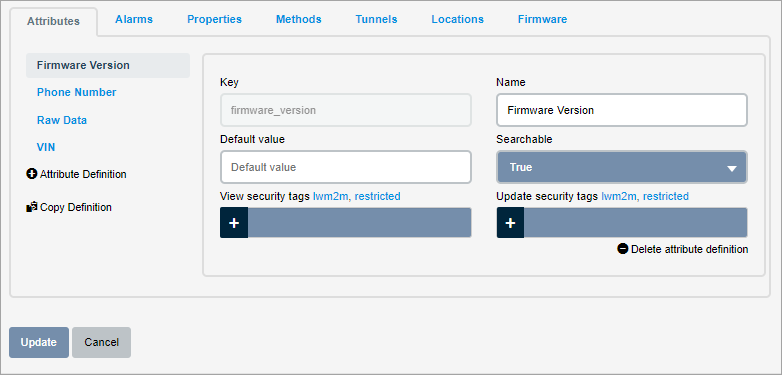Defining Attributes
The Attributes tab is used to define attributes for the Thing definition. Attributes are key-value pairs used to define attributes of a Thing. For example, the VIN on a car, a serial number of a piece of equipment, a customer name, and so on. If the Auto def attributes field is selected in the Thing definition, a Thing automatically defines a attributes key-value pairs.
Unlike properties and alarms, attributes do not have a timestamp component, so they cannot be graphed on the Thing's page in the Management Portal. The attribute's value is displayed while Viewing a Thing.
Defining Attributes is a sub task while Creating a Thing definition or Editing a Thing definition. To define the Attributes, do the following:
-
While Creating a Thing
definition or Editing a Thing
definition, under the Standard tab, click on
the Attributes tab

- Enter or select the fields for the new attribute
definition. The fields are:
Field Description Key The key for the attribute definition.
A key is an identifier that must be globally unique within the organization.
The valid characters for a key are letters, numbers, "_" (underscore), and "-" (hyphen).To find all Things that have the attribute key set to a certain value through the 'Search' functionality, the precondition is that the attribute must be 'searchable'.
Only the data updated (with a new value's entry) after the attribute has been set searchable=true will be found; while the data updated before the attribute had searchable=true will remain not findable. In that case it is needed a workaround.Name The name of the attribute definition that is displayed on Management Portal pages. Default value The value that should be returned if the attribute has never been set before. This value will not be returned in thing.find, thing.list, nor thing.search API commands. Will be returned by the attribute.current API command if no value has been defined for this attribute. Searchable Indicates if this attribute is searchable. If set to true, you will be able to find the attribute while searching. For a Thing, the maximum number of attributes, alarms, or properties is limited to 32 each. If you have more than the permitted limit, then the attributes, alarms, or properties will not be indexed and is not searchable. View security tags Enter any number of tags to the attribute that controls whether a user or application can view the attribute. The user or application must have a role that has the same view security tag associated with it in order to view an attribute with a view security tag associated with it. Update security tags Enter any number of tags to the attribute that controls whether a user or application can update the attribute. The user or application must have a role that has the same update security tag associated with it in order to update an attribute with an update security tag associated with it. - click on the
 to add New attribution
definition.
to add New attribution
definition. - Click on the
 to delete the
currently displayed attribute.
to delete the
currently displayed attribute. - (optional)Click on the
 to list all the attributes from all the Thing definitions. You will be able to select the attribute you want and copy it to your Thing definition.
to list all the attributes from all the Thing definitions. You will be able to select the attribute you want and copy it to your Thing definition.